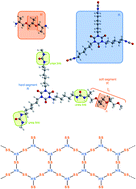Two glass transitions of polyurea networks: effect of the segmental molecular weight
Abstract
Polymer–nanoparticle composites (PNCs) play an increasing role in technology. Inorganic or organic nanoparticles are usually incorporated into a polymer matrix to improve material properties. Polyurea is a spontaneously occurring PNC, exhibiting a phase segregated structure with hard nanodomains embedded in a soft (elastically compliant) matrix. This system shows two glass transitions at Tg1 and Tg2. It has been argued that they are related to the freezing of motion of molecular segments in the soft matrix (usual polymer α-glass transition at Tg1) and to regions of restricted mobility near the hard nanodomains (α′-process) at Tg2, respectively. We present detailed dynamic mechanical analysis (DMA) measurements for polyurea networks with different segmental lengths lc (2.5, 12.1, 24.5 nm) of the polymer chains, i.e. different volume fractions ϕx (0.39, 0.12, 0.07) of the hard domains. The two glass transitions show up in two distinct peaks in tan δ at Tα and Tα′. Analysing the data using a Havriliak–Negami term for the α- and α′-relaxation, as well as Vogel–Fulcher dependencies for the corresponding relaxation times, it is found that the α-glass transition at Tg1 increases strongly (up to ΔT = 70 K) with increasing ϕx, whereas the α′-transition at Tg2 remains unchanged. At ϕcx ≈ 0.19 the two curves intersect, i.e. Tg1 = Tg2. This value of ϕcx is very close to the percolation threshold of randomly oriented overlapping ellipsoids of revolution with an aspect ratio of about 1 : 4–1 : 5. We therefore conclude that around 19% of the hard nanodomains polyurea changes from a system of hard nanoparticles embedded in a soft matrix (ϕx ≤ ϕcx) to a system of soft domains confined in a network of percolated hard domains at ϕx ≥ ϕcx.


 Please wait while we load your content...
Please wait while we load your content...